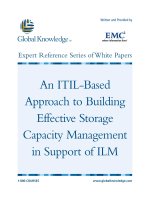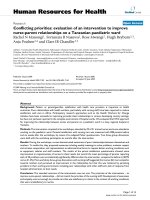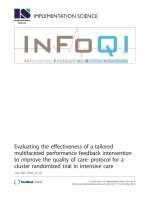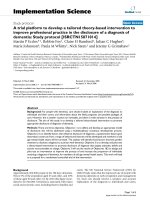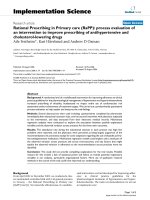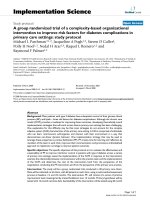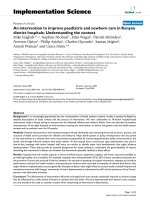Application of an appearance based intervention to improve sun protection outcomes of outdoor workers in queensland, australia
Bạn đang xem bản rút gọn của tài liệu. Xem và tải ngay bản đầy đủ của tài liệu tại đây (6.07 MB, 395 trang )
Application of an Appearance-Based
Intervention to Improve Sun
Protection Outcomes of Outdoor
Workers in Queensland, Australia
Katja Saris
Bachelor of Science; Master of Science
(University of Maastricht)
Submitted in fulfilment of the requirements for the degree of
Doctor of Philosophy
School of Public Health
Faculty of Health
Queensland University of Technology
Brisbane, Australia
May 2012
Keywords
Appearance-based intervention, behaviour, facial UV-photograph, intention,
intervention, leisure time, organisation, outdoor workers, quantitative, risk perception,
skin cancer prevention, sun safety policy, theory, work time
i|Page
ii | P a g e
List of Abbreviations
ARPANSA
Australian Radiation Protection and Nuclear Safety Agency
BCC
Basal Cell Carcinoma
BL
Baseline
BRAT
Brief skin cancer risk assessment tool
FU
Follow-up
GEE
Generalised Estimating Equations
GP
General Practitioner
HBM
Health Belief Model
HPV
Human Papiloma Virus
H&S
Health and Safety
i-Change
Integrated Model for Change
ICNIRP
International Commission on Non-Ionizing Radiation Protection
MM
Malignant Melanoma
NCI
National Cancer Institute (USA)
nm
Nanometers
NHMRC
National Health and Medical Research Council
NMSC
Non Melanoma Skin Cancer
POWER
Protection of Outdoor Workers from Environmental Radiation
PPE
Personal Protective Equipment
QUT
Queensland University of Technology
SCC
Squamous Cell Carcinoma
SCRAT
Skin Cancer Risk Assessment Tool
SCT
Social Cognitive Theory
SPF
Sun Protection Factor
TTM
Transtheoretical model
iii | P a g e
UV
Ultraviolet
UVR
Ultraviolet Radiation
WHO
World Health Organisation
iv | P a g e
Definitions for this Thesis
Policy is defined as having work sun protection measures and risk management in place
for employees to protect from the risks of sun exposure.
Current: belonging to the present time.
Practice: habitual or customary performance regarding sun protection.
Sun protection: protection of the skin and eyes through the use of shade, clothing and/or
sunscreen.
Outdoor worker: a person that spends at least half of their time outside
working day) working in an outdoor environment. According to Stepanski and Mayer
(1998) outdoor workers typically spend 30 work hours or more per week exposed to
UVR.
Change: a transformation or modification; alteration.
Intervention group: a group(s) of people that undergo the same study condition which
includes the intervention part of the study. The intervention part is meant to be the
effective changing component of the study.
Control group: a group(s) of people that undergo the same study condition and do not
undergo the intervention part of the study.
Effectiveness: adequate to accomplish a purpose; producing the intended or expected
result.
Impact: to have an effect on; influence; alter.
v|Page
Stringent sun protection policy setting: having an organisational policy that protects
employees from the risks of sun exposure that is clear and consciously implemented and
reviewed.
Less stringent sun protection policy setting: not having a stringent organisational policy
in place for the protection of employees.
vi | P a g e
Abstract
Outdoor workers are exposed to high levels of ultraviolet radiation (UVR) and may thus
be at greater risk to experience UVR-related health effects such as skin cancer, sun burn,
and cataracts. A number of intervention trials (n=14) have aimed to improve outdoor
-related sun protection cognitions and behaviours. Only one study
however has reported the use of UV-photography as part of a multi-component
intervention. This study was performed in the USA and showed long-term (12 months)
improvements in work-related sun protection behaviours. Intervention effects of the
other studies have varied greatly, depending on the population studied, intervention
applied, and measurement of effect. Previous studies have not assessed whether:
-
Interventions are similarly effective for workers in stringent and less stringent
policy organisations;
-
P
-
Implemented interventions are effective in the long-term;
-
The facial UV-photograph technique is effective in Australian male outdoor
workers without a large additional intervention package, and;
-
“
-related cognitions
and behaviours.
Therefore, the present Protection of Outdoor Workers from Environmental Radiation
[POWER]-study aimed to fill these gaps and had the objectives of: a) assessing outdoor
-related cognitions and behaviours at work and during leisure time in
stringent and less stringent sun protection policy environments; b) assessing the effect of
an appearancebehaviours over time; c) assessing whether the intervention was equally effective within
vii | P a g e
the two policy settings; and d) assessing the immediate post-intervention effect.
Effectiveness was described in terms of changes in sun-related risk perceptions and
intentions (as these factors were shown to be main precursors of behaviour change in
many health promotion theories) and behaviour.
The study purposefully selected and recruited two organisations with a large outdoor
worker contingent in Queensland, Australia within a 40 kilometre radius of Brisbane. The
two organisations differed in the stringency of implementation and reinforcement of
their organisational sun protection policy. Data were collected from 154 male
predominantly Australian born outdoor workers with an average age of 37 years and
predominantly medium to fair skin (83%). Sun-related cognitions and behaviours of
workers were assessed using self-report questionnaires at baseline and six to twelve
months later. Variation in follow-up time was due to a time difference in the recruitment
of the two organisations. Participants within each organisation were assigned to an
intervention or control group. The intervention group participants received a one-off
personalised Skin Cancer Risk Assessment Tool [SCRAT]-letter and a facial UVphotograph with detailed verbal information. This was followed by an immediate postintervention questionnaire within three months of the start of the study. The control
group only received the baseline and follow-up questionnaire.
Data were analysed using a variety of techniques including: descriptive analyses,
parametric and non-parametric tests, and generalised estimating equations. A 15%
proportional difference observed was deemed of clinical significance, with the addition
of reported statistical significance (p<0.05) where applicable.
Objective 1: Assess and compare the current sun-related risk perceptions, intentions,
behaviours, and policy awareness of outdoor workers in stringent and less stringent sun
protection policy settings. Workers within the two organisations (stringent n=89 and less
viii | P a g e
stringent n=65) were similar in their knowledge about skin cancer, self efficacy, attitudes,
and social norms regarding sun protection at work and during leisure time. Participants
were predominantly in favour of sun protection. Results highlighted that compared to
workers in a less stringent policy organisation working for an organisation with stringent
sun protection policies and practices resulted in more desirable sun protection intentions
(less willing to tan p=0.03) ; actual behaviours at work (sufficient use of upper and lower
body protection, headgear, and sunglasses (p<0.001 for all comparisons), and greater
policy awareness (awareness of repercussions if Personal Protective Equipment (PPE)
was not used, p<0.001)). However the effect of the work-related sun protection policy
was found not to extend to leisure time sun protection.
Objective 2: Compare changes in sun-related risk perceptions, intentions, and behaviours
between the intervention and control group. The effect of the intervention was minimal
and mainly resulted in a clinically significant reduction in work-related self-perceived risk
of developing skin cancer in the intervention compared to the control group (16% and
32% for intervention and control group, respectively estimated their risk higher
compared to other outdoor workers: , p=0.11). No other clinical significant effects were
observed at 12 months follow-up.
Objective 3: Assess whether the intervention was equally effective in the stringent sun
protection policy organisation and the less stringent sun protection policy organisation.
The appearance-based intervention resulted in a clinically significant improvement in the
work (workplace*time interaction, p=0.01). In addition to a reduction in their willingness
to tan both at work (will tan at baseline: 17% and 61%, p=0.06, at follow-up: 54% and
33%, p=0.07, stringent and less stringent policy intervention group respectively. The
workplace*time interaction was significant p<0.001) and during leisure time (will tan at
ix | P a g e
baseline: 42% and 78%, p=0.01, at follow-up: 50% and 63%, p=0.43, stringent and less
stringent policy intervention group respectively. The workplace*time interaction was
significant p=0.01) over the course of the study compared to the less stringent policy
intervention group. However, no changes in actual sun protection behaviours were
found.
Objective 4: Examine the effect of the intervention on level of alarm and concern
regarding the health of the skin as well as sun protection behaviours in both
organisations. The immediate post-intervention results showed that the stringent policy
organisation participants indicated to be less alarmed (p=0.04) and concerned (p<0.01)
about the health of their skin and less likely to show the facial UV-photograph to others
(family p=0.03) compared to the less stringent policy participants. A clinically significantly
larger proportion of participants from the stringent policy organisation reported they
worried more about skin cancer (65%) and skin freckling (43%) compared to those in the
less stringent policy organisation (46%,and 23% respectively , after seeing the UVphotograph).
In summary the results of this study suggest that the having a stringent work-related sun
protection policy was significantly related to for work-time sun protection practices, but
did not extend to leisure time sun protection. This could reflect the insufficient level of
sun protection found in the general Australian population during leisure time.
Alternatively, reactance caused by being restricted in personal decisions through worktime policy could have contributed to lower leisure time sun protection. Finally, other
factors could have also contributed to the less than optimal leisure time sun protection
behaviours reported, such as unmeasured personal or cultural barriers. All these factors
combined may have lead to reduced willingness to take proper preventive action during
leisure time exposure.
x|Page
The intervention did not result in any measurable difference between the intervention
and control groups in sun protection behaviours in this population, potentially due to the
long lag time between the implementation of the intervention and assessment at 12months follow-up. In addition, high levels of sun protection behaviours were found at
baseline (ceiling effect) which left little room for improvement. Further, this study did
not assess sunscreen use, which was the predominant behaviour assessed in previous
effective appearance-based interventions trials. Additionally, previous trials were mainly
conducted in female populations, whilst the POWER-
T
observed immediate post-intervention result could be due to more emphasis being
placed on sun protection and risks related to sun exposure in the stringent policy
organisation. Therefore participants from the stringent policy organisation could have
been more aware of harmful effects of UVR and hence, by knowing that they usually
protect adequately, not be as alarmed or concerned as the participants from the less
stringent policy organisation.
In conclusion, a facial UV-photograph and SCRAT-letter information alone may not
achieve large changes in sun-related cognitions and behaviour, especially of assessed 612 months after the intervention was implemented and in workers who are already quite
well protected. Differences found between workers in the present study appear to be
more attributable to organisational policy. However, against a background of
organisational policy, this intervention may be a useful addition to sun-related workplace
health and safety programs.
The study findings have been interpreted while respecting a number of limitations. These
have included non-random allocation of participants due to pre-organised allocation of
participants to study group in one organisation and difficulty in separating participants
from either study group. Due to the transient nature of the outdoor worker population,
xi | P a g e
only 105 of 154 workers available at baseline could be reached for follow-up. (attrition
rate=32%). In addition the discrepancy in the time to follow-up assessment between the
two organisations was a limitation of the current study.
Given the caveats of this research, the following recommendations were made for future
research:
-
C
outside at work as well as in the way sun protection behaviours are measured
and reported.
-
Future studies should implement and assess the value of the facial UVphotographs in a wide range of outdoor worker organisations and countries.
-
More timely and frequent follow-up assessments should be implemented in
intervention studies to determine the intervention effect and to identify the best
timing of booster sessions to optimise results.
-
F
cognitions and behaviours and improve these if possible.
Overall, policy appears to be an
-time
use of sun protection. Given the evidence generated by this research, organisations
employing outdoor workers should consider stringent implementation and
reinforcement of a sun protection policy. Finally, more research is needed to improve
ways to generate desirable behaviour in this population during leisure time.
xii | P a g e
Table of Contents
Keywords .............................................................................................................. i
List of Abbreviations ........................................................................................... iii
Definitions for this Thesis ..................................................................................... v
Abstract ............................................................................................................. vii
List of Figures ..................................................................................................... xix
List of Tables ...................................................................................................... xxi
Statement of Original Authorship ...................................................................... xxv
Acknowledgements ......................................................................................... xxvii
1.
Introduction .............................................................................................................. 1
1.1.
Problem statement ........................................................................................... 1
1.2.
Overall research aims ....................................................................................... 2
1.3.
Research approach ........................................................................................... 2
2.
Background ............................................................................................................... 5
2.1
Outdoor Workers .............................................................................................. 5
2.1.1
What defines an outdoor worker? .......................................................... 5
2.1.2
Why are outdoor workers at risk? ........................................................... 6
2.1.3
Requirements of Australian workplaces to limit UVR exposure.............. 8
2.1.4
Occupational sun exposure and sun protection behaviours of outdoor
workers and related policy .................................................................................... 10
Sun exposure of outdoor workers ..................................................................... 11
Sun protection behaviours among outdoor workers ........................................ 12
Predictors of sun protection for outdoor workers ............................................ 15
The effect of sun protection policy .................................................................... 16
2.1.5
time
Sun exposure and sun protection of outdoor workers during leisure
............................................................................................................... 16
2.1.6
I
cognitions and behaviours ..................................................................................... 18
2.1.7
2.2
Summary ................................................................................................ 26
Skin cancer ...................................................................................................... 28
2.2.1
What is skin cancer? .............................................................................. 28
2.2.2
Incidence and mortality ......................................................................... 30
2.2.3
Skin cancer risk factors .......................................................................... 32
Non-modifiable risk factors ............................................................................... 32
xiii | P a g e
Modifiable risk factors........................................................................................ 34
Risk factors for specific skin cancer types .......................................................... 34
2.2.4
Sun protection methods to reduce risk of skin cancer........................... 37
2.2.5
Summary................................................................................................. 39
2.3
Risk communication ....................................................................................... 40
2.3.1
How is risk information processed? ....................................................... 40
2.3.2
What is effective risk communication? .................................................. 42
2.3.3
Risk communication in relation to generating behaviour change ......... 44
2.4
Skin cancer prevention and health promotion .............................................. 47
2.4.1
Theories of health behaviour ................................................................. 47
Social Cognitive Theory ...................................................................................... 47
Transtheoretical Model ...................................................................................... 50
Health Belief Model............................................................................................ 52
2.4.2
Theories of health behaviour applied in skin cancer prevention studies ..
................................................................................................................ 54
2.4.3
History overview of skin cancer prevention campaigns in Australia...... 57
2.4.4
Skin cancer prevention intervention components ................................. 61
2.4.5
Challenges in measuring behavioural changes in skin cancer prevention
research ................................................................................................................ 69
2.4.6
Summary................................................................................................. 73
2.5
Systematic review: Appearance-based interventions .................................... 75
2.6
Overview of the background .......................................................................... 94
3
Methods ................................................................................................................. 97
3.1
Research directions and importance.............................................................. 97
3.2
Study overview ............................................................................................... 98
Aims .................................................................................................................... 99
3.3
Ethics ............................................................................................................ 101
3.4
Design ........................................................................................................... 101
3.5
Participants ................................................................................................... 102
3.5.1
Selection criteria for industries and participants ................................. 102
3.5.2
Recruitment .......................................................................................... 104
3.5.3
Workplace characteristics and setting ................................................. 105
3.6
POWER-study ............................................................................................... 111
3.6.1
Intervention grounding and development ........................................... 111
3.6.2
Questionnaires ..................................................................................... 113
xiv | P a g e
3.6.3
Intervention components .................................................................... 122
SCRAT-letter ..................................................................................................... 122
Facial UV-photograph ...................................................................................... 124
3.6.4
Flow of study procedures and data collection..................................... 126
3.6.5
Conducting the intervention ................................................................ 127
3.6.6
Follow-up ............................................................................................. 128
3.7
Outcomes ...................................................................................................... 130
3.8
Sample size and power ................................................................................. 133
3.9
Allocation of participants .............................................................................. 136
3.10
Statistical considerations .............................................................................. 137
3.10.1
Data cleaning ....................................................................................... 137
3.10.2
Analytical plan: Treatment of data and assumptions .......................... 138
3.10.3
Significance of results .......................................................................... 140
3.10.4
Data analyses: Objective one............................................................... 142
3.10.5
Data analyses: Objective two............................................................... 144
Regression........................................................................................................ 150
3.10.6
Data analyses: Objective three ............................................................ 151
Regression........................................................................................................ 153
3.10.7
Data analyses: Objective four .............................................................. 155
3.10.8
Overview of the data analyses conducted in the POWER-study ......... 157
4
Results................................................................................................................... 159
4.1
Participant enrolment ................................................................................... 159
4.2
Participant characteristics ............................................................................ 161
4.3
Objective 1 .................................................................................................... 172
4.3.1
4.4
Objective 2 .................................................................................................... 187
4.4.1
Regression results ................................................................................ 187
4.4.2
Summary of results objective 2 ........................................................... 194
4.5
Objective 3 .................................................................................................... 195
4.5.1
Regression results ................................................................................ 196
4.5.2
Summary of results objective 3 ........................................................... 203
4.6
Objective 4 .................................................................................................... 205
4.6.1
5.
Summary of results objective 1 ........................................................... 185
Summary of results objective 4 ........................................................... 209
Discussion ............................................................................................................. 211
xv | P a g e
5.1
The aims of the POWER-study...................................................................... 211
5.2
POWER-study findings and challenges ......................................................... 213
5.3
Comparing the POWER-study and the Iowa road workers study ................ 214
5.4
Organisational sun protection policy and its impact .................................... 219
5.4.1
Other environmental influences and work-related protection ........... 224
5.4.2
Leisure time behaviour ......................................................................... 226
5.5
The effect of an appearance-based intervention ......................................... 229
5.5.1
Intention and behaviour effects ........................................................... 230
5.5.2
Immediate intervention effects ........................................................... 232
5.6
Limitations of the POWER-study .................................................................. 234
5.6.1
Study assessment methods, design and recruitment .......................... 234
5.6.2
Limitations in the types of sun protection behaviour assessed ........... 238
5.7
Strengths and recommendations ................................................................. 239
5.7.1
Strengths of the POWER-study and recommendations for research and
practice .............................................................................................................. 239
5.7.2
5.8
Final reflections .................................................................................... 242
Conclusion .................................................................................................... 243
REFERENCES ..................................................................................................................... 245
Appendix A: Overview of intervention studies aimed at outdoor workers to change
skin cancer-related cognitions and behaviour ................................................................. 265
Appendix B: Overview of descriptive studies and interventions focussing on outdoor
workers ............................................................................................................................. 273
Appendix C: Outdoor worker review protocol ................................................................. 277
Appendix D: Systematic review protocol ......................................................................... 281
Appendix E: Ethics approval ............................................................................................. 285
Appendix F: Newsletter .................................................................................................... 287
Appendix G: Health and safety officer questions ............................................................. 289
Appendix H: Participant information sheet...................................................................... 291
Appendix I: Consent form................................................................................................. 295
Appendix J: Overview of all the Baseline questions and their justification/validation .... 297
Appendix K: Baseline questionnaire ................................................................................. 301
Appendix L: Follow-up questionnaire .............................................................................. 313
Appendix M: Immediate post-intervention questionnaire .............................................. 339
Appendix N: SCRAT-letter................................................................................................. 341
Appendix O: SCRAT-score calculation .............................................................................. 343
xvi | P a g e
Appendix P: Intervention script ........................................................................................ 345
Appendix Q: Thank you letter ........................................................................................... 347
Appendix R: Overview of collapsed variables in the baseline questionnaire ................... 349
Appendix S: Results of objective two with 95% confidence intervals for the proportions
within the control and intervention group ....................................................................... 351
Appendix T: Results of objective three with 95% confidence intervals for the
proportions within the less stringent and stringent policy organisation intervention
groups .............................................................................................................................. 355
Appendix U: Association between level of concern, alarm, and SCRAT-letter category
of the intervention group participants with the three risk perception questions at
follow-up ........................................................................................................................... 359
xvii | P a g e
xviii | P a g e
List of Figures
Figure 1. Incidence rates for melanoma (a) and all cancers combined (b) per age category
(AIHW, 2010a).................................................................................................................... 29
Figure 2. Incidence (a) and mortality (b) rates for malignant melanoma for men and
women per 100,000 people (Adapted from the AIHW, 2010a) ........................................ 31
Figure 3. The triadic relationship of the constructs of the SCT (Bandura, 1986) .............. 49
Figure 4. Stages of change in the Transtheoretical Model (Prochaska, 1984) .................. 51
Figure 5. The Health Belief Model (Janz & Becker, 1984).................................................. 53
Figure 6. The Cancer Council Australia SunSmart campaign logo (The Cancer Council
Victoria, 2011).................................................................................................................... 58
Figure 7. Study design of the POWER-study .................................................................... 102
Figure 8. Enrolled number of participants in each study condition per organisation ..... 109
Figure 9. Example of a UV-photograph indicating damage to the skin potentially due to
UVR exposure .................................................................................................................. 124
Figure 10. Study overview and participant time commitment........................................ 126
Figure 11. Model for pathways of the constructs assessed in the POWER-study and their
relation to one another ................................................................................................... 131
Figure 12. Overview of total participant involvement in the POWER-study per
organisation ..................................................................................................................... 135
Figure 13. Schematic overview of the relation of objective one to the design of the
POWER-study ................................................................................................................... 142
Figure 14. Schematic overview of the relation of objective two to the design of the
POWER-study ................................................................................................................... 144
Figure 15. Schematic overview of the relation of objective three to the design of the
POWER-study ................................................................................................................... 151
Figure 16. Schematic overview of the relation of objective four to the design of the
POWER-study ................................................................................................................... 155
Figure 17. Flow diagram of participant involvement....................................................... 159
xix | P a g e
xx | P a g e
List of Tables
Table 1. An overview of assessed and improved sun protection behaviours of outdoor
workers in order of variety of types of protection behaviours assessed (the more variety
the better) to overall protection score and study efficacy ................................................ 23
Table 2. Studies using appearance-based (UV-imaging) interventions to change skin
cancer-related cognitions and behaviours ........................................................................ 79
Table 3. Overview of sun protection behaviours assessed and changed in the facial UVimaging interventions ........................................................................................................ 88
Table 4. Selection criteria for study organisation participants ........................................ 104
Table 5. C
organisation and the less stringent policy organisation to the Australian Radiation
Protection and Nuclear Safety Agency (ARPANSA) standard .......................................... 107
Table 6. Overview of study assessment and intervention materials (shaded in grey) .... 111
Table 7. Overview of assessment instruments ................................................................ 113
Table 8. Overview of the additional variables measured at follow-up and their
measurement properties ................................................................................................. 117
Table 9. Overview of measured variables and their statistical background at the
intervention time ............................................................................................................. 118
Table 10. Reliability of some constructs in the baseline questionnaire of the POWERstudy ................................................................................................................................ 121
Table 11. Overview of dates and locations the POWER-study was conducted ............... 130
Table 12. Additional evidence for the importance of the outcome measures of this study
......................................................................................................................................... 132
Table 13. An overview of the clinically and statistically significant differences between
the intervention and control group at baseline .............................................................. 146
Table 14. Outline and properties of the adjusting variables and the eleven outcome
measures.......................................................................................................................... 147
Table 15. An overview of the significant differences between the stringent and less
stringent intervention policy groups at baseline ............................................................. 152
Table 16. Overview of the study objectives with related questions and statistical methods
used for analysis .............................................................................................................. 157
xxi | P a g e
Table 17. Descriptive characteristics of the demographic variables of the total participant
population, the stringent policy organisation and the less stringent policy organisation
.......................................................................................................................................... 162
Table 18. Phenotype, health, skin, and skin cancer-related factors of the total participant
population, the stringent policy organisation and the less stringent policy organisation
.......................................................................................................................................... 164
Table 19. Sun exposure and sun protection-related cognitions of the total participant
population, the stringent policy organisation and the less stringent policy organisation
.......................................................................................................................................... 168
Table 20. Baseline results for the current risk perception in a stringent policy versus less
stringent policy outdoor worker organisation with 95% confidence............................... 173
Table 21. Baseline results for the current intention in a stringent policy versus less
stringent policy outdoor worker organisation with 95% confidence............................... 175
Table 22. Baseline results for the current behaviour in a stringent policy versus less
stringent policy outdoor worker organisation ................................................................. 179
Table 23. Baseline results for the current policy awareness in a stringent policy versus
less stringent policy outdoor worker organisation .......................................................... 183
Table 24. Risk perceptions, intentions, behaviours, and differences in policy awareness
found that were more desirable for work and leisure time-related sun protection in the
stringent policy organisation and the less stringent policy organisation ........................ 186
Table 25. Odds Ratios (ORs) or mean and standard error (SE) with 95% Confidence
Intervals (CIs) and proportions for risk perception, intention, and behaviour of the
control group compared to the intervention group at each time point (baseline and
follow-up) and over time.................................................................................................. 190
Table 26. Odds Ratios (ORs) or mean and standard error (SE) with 95% Confidence
Intervals (CIs) and proportions for risk perception, intention, and behaviour of the Less
stringent policy organisation intervention group compared to the Stringent policy
organisation intervention group at each time point (baseline and follow-up) and over
time .................................................................................................................................. 199
Table 27. Overview of the immediate effect of the facial UV-photograph and SCRATletter information with 95% confidence intervals ........................................................... 205
Table 28. Overview of the effect of the facial UV-photograph and SCRAT-letter
information at follow-up with 95% confidence intervals................................................. 207
Table 29. Comparison of the Iowa road workers study and the POWER-study............... 215
xxii | P a g e
Table 30. Overview of workplace policy on main outcomes in proportion of participants
between the POWER-study and the study by Woolley et al. (2008)............................... 222
xxiii | P a g e
